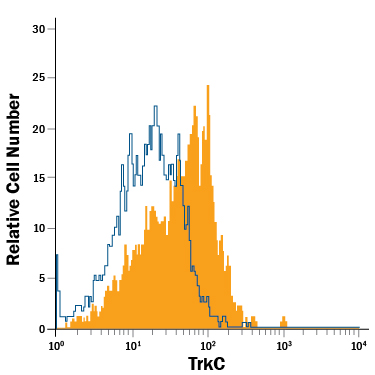Human TrkC PE-conjugated Antibody Summary
Cys32-Asp428
Accession # Q16288
Applications
Please Note: Optimal dilutions should be determined by each laboratory for each application. General Protocols are available in the Technical Information section on our website.
Scientific Data
 View Larger
View Larger
Detection of TrkC in Differentiated Human Neural Progenitor Cells by Flow Cytometry. Differentiated human neural progenitor cells were stained with Goat Anti-Human TrkC PE-conjugated Antigen Affinity-purified Polyclonal Antibody (Catalog # FAB373P, filled histogram) or isotype control antibody (Catalog # IC108P, open histogram). View our protocol for Staining Membrane-associated Proteins.
Reconstitution Calculator
Preparation and Storage
Background: TrkC
The neurotrophins, including NGF, BDNF, NT-3 and NT-4/5, constitute a group of structurally related, secreted proteins that play an important role in the development and function of the nervous system. The biological activities of the neurotrophins are mediated by binding to and activating two unrelated receptor types: the p75 neurotrophin receptor (p75NTR) and the Trk family of receptor tyrosine kinases. p75NTR is a member of the tumor necrosis factor receptor superfamily (TNFRSF) and has been designated TNFRSF16. Although it binds all neurotrophins with low-affinity, it complexes with the Trks to form high affinity neurotrophin receptors, and with Sortilin to form high affinity receptors for the proneurotrophins. Three Trk family proteins, TrkA, TrkB and TrkC, that exhibit different ligand specificities have been identified. TrkA binds NGF and NT‑3, TrkB binds BDNF, NT-3 and NT-4/5, and TrkC binds NT-3 and BDNF. All Trk family proteins share a conserved, complex subdomain organization consisting of two cysteine-rich domains, a cluster of three leucine-rich motifs, and two immunoglobulin-like domains in their extracellular region, as well as an intracellular region that contains a tyrosine kinase domain. Natural splice variants of the different Trks, lacking the first cysteine-rich domain, the first and second or all three of the leucine-rich motifs, or the tyrosine kinase domain, have been described. At the protein sequence level, Trks are highly conserved between species with the extracellular domains of human and mouse TrkC showing 94% amino acid sequence identity. The proteins also exhibit cross-species activity. The 135-140 kDa full-length form of TrkC has been found in select embryonic tissues (dorsal root ganglia neurons; renal collecting ducts) and multiple adult cell types, including cortical neurons, astrocytes, endothelial cells, vascular smooth muscle cells, melanocytes, ovarian granulosa cells, and neural stem cells.
Product Datasheets
Citation for Human TrkC PE-conjugated Antibody
R&D Systems personnel manually curate a database that contains references using R&D Systems products. The data collected includes not only links to publications in PubMed, but also provides information about sample types, species, and experimental conditions.
1 Citation: Showing 1 - 1
-
Neurotrophins regulate bone marrow stromal cell IL-6 expression through the MAPK pathway.
Authors: Rezaee F, Rellick SL, Piedimonte G
PLoS ONE, 2010-03-15;5(3):e9690.
Species: Human
Sample Types: Whole Cells
Applications: Flow Cytometry
FAQs
No product specific FAQs exist for this product, however you may
View all Antibody FAQsReviews for Human TrkC PE-conjugated Antibody
There are currently no reviews for this product. Be the first to review Human TrkC PE-conjugated Antibody and earn rewards!
Have you used Human TrkC PE-conjugated Antibody?
Submit a review and receive an Amazon gift card.
$25/€18/£15/$25CAN/¥75 Yuan/¥2500 Yen for a review with an image
$10/€7/£6/$10 CAD/¥70 Yuan/¥1110 Yen for a review without an image



